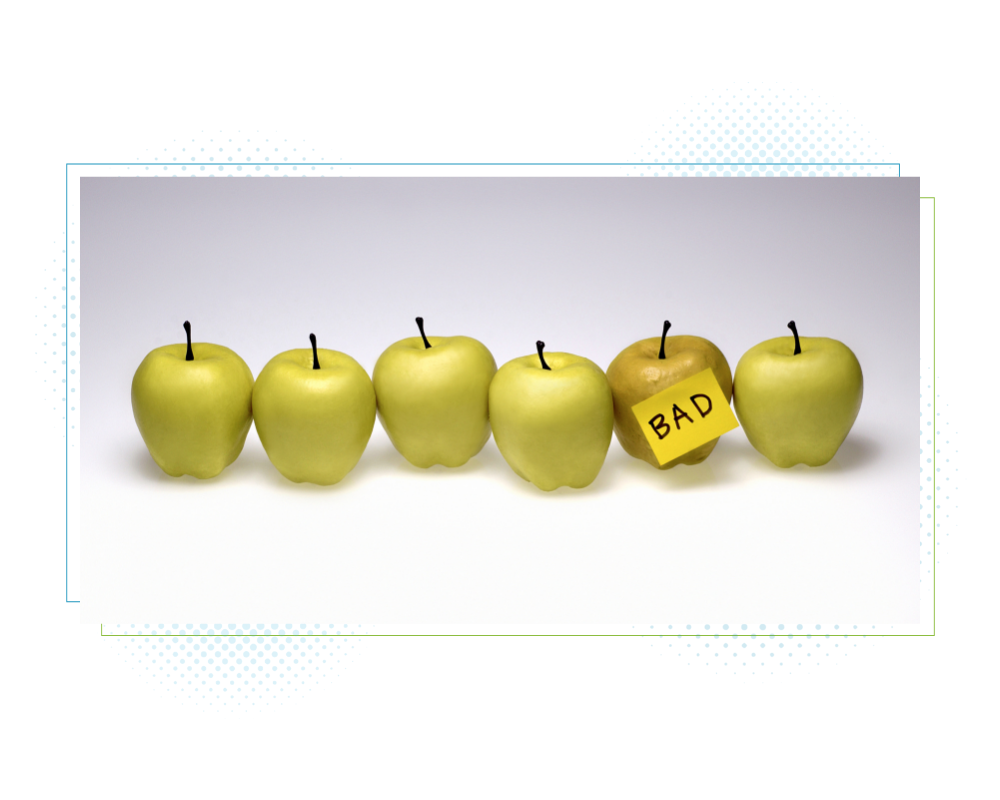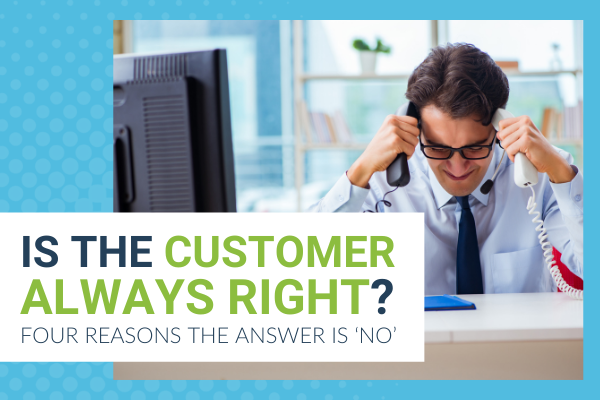Because I’m such a fierce advocate for creating amazing customer experiences, it might come as a surprise to some that I believe the old adage that “the customer always being right” is not only incorrect and outdated. It’s also potentially harmful in its widespread acceptance.
In response to the question “Is the customer always right?” the answer is no. The customer isn’t always right. Some customers are abusive, belligerent, or otherwise awful, and no company or business owner – large or small – should be afraid to stand up to those customers with a clear and simple message: We don’t want or need your business. Goodbye.
Admittedly, other customers may not be “bad” in the traditional sense, or in the way characterized in the paragraph above, but they can certainly be wrong. Here’s the tricky part, though — although the customer isn’t always right, the customer likely thinks he or she is right. This is largely why navigating situations with “bad” customers can be challenging… especially when you factor how “shareable” every customer interaction potentially becomes, between review sites and social media. More on the best ways to handle those situations below. 👇
In the meantime, let’s talk about why it’s okay to turn away exceptionally tough customers. That way, the next time you hear someone ask, “Is the customer always right?” you can answer with a loud and definitive, “NO!” and cite one of the four reasons below.
1. Tolerating to bad customers costs you good employees.
First and foremost, managing every customer interaction is an employee trained to handle concerns or complaints. However, when customers turn those concerns into baseless abuse, that’s a problem. While it’s true that everyone has bad days, and some businesses are accustomed to dealing with customers who are at the worst moments of their lives (divorce attorneys, funeral homes, etc.), there’s a difference between a customer having a bad day and a customer being abusive or belligerent.

If you don’t stand up for your employees when customers antagonize them, it will breed problems on multiple fronts. For one thing, employees can only support customers if they are first supported by the rest of their team. If you allow bad customers to be abusive, your employees will likely feel unappreciated and therefore provide inferior service to all customers, good and bad alike. Additionally, while some employees will put up with abuse, others will quit to find an environment where they’re more supported.
For example, at one of my previous jobs, one client was notoriously horrible, and no one stayed on her account for long, myself included. When I finally couldn’t take any more unwarranted abuse, I approached the owners of the company and was told, “Look, we know she’s terrible, but we really just need you to take one for the team here.” It didn’t take long for me to decide I didn’t want to be part of that “team” anymore. Ultimately, I left, founded my own company, and more than once in the decade that followed, fired clients for disrespecting my employees.
In your own business, the same choice is also possible: support your employees and say ‘no’ to “Is the customer always right?” or put up with bad customers and ensure a high employee turnover rate.
2. Bad customers steal resources from good customers.
The second argument against “Is the customer always right?” is the resources bad customers consume. On top of taking away employee happiness, bad customers also take away from good customers. In terms of time, attention, and resources, dealing with abusive customers means expending efforts that could be otherwise directed to serving good customers.
Plus, no customer’s experience is going to be enhanced by seeing a bad customer make a scene. Whether that scene is literal (like a freak-out in a store), or virtual (like a meltdown review), a bad customer can change the entire atmosphere around your business, making good customers or potential customers feel uncomfortable. Furthermore, even though a meltdown always ends eventually, the impact can stick around for much longer. I’m guessing you’ve already seen the social media videos, blog articles, and news stories that make such tantrums hard to forget.
To minimize the damage in situations like this, don’t try to respond to every point in a complaint or accusation. Doing so will only antagonize the customer further, especially if it’s an online exchange. Instead, if you’ve exhausted all possible resources for making things good, simply apologize and wish the customer well at whatever establishment they take their business to moving forward. Think of it as a corporate version of, “Goodbye and good luck!”
3. Some people will never, ever be happy.
The third argument against “Is the customer always right?” is that some simply can’t be pleased, and trying to please all of your customers is a fruitless exercise. You should always strive to provide excellent customer service and do everything in your power to right a wrong. However, you should also acknowledge that some customers will never, ever be happy, and the quicker you cut your losses and run, the sooner you can move on with your life and your business.

Personally, I’ll never forget being at a Super Bowl party in Manhattan in 2011. The New York Giants beat the Patriots and, for about 10 minutes, all the Giants fans were thrilled. But, by the time the post-game show was over, two fans were disgruntled. “Great — we’re going to get the last draft pick now,” one said. “Yeah, which really sucks, because I bet so-and-so and someone-else are going to retire now that they’ve got their rings,” the other answered (except with real player names). Their team WON THE SUPER BOWL, and yet these self-proclaimed superfans were bitter less than 30 minutes later.
In the same way, in business, some customers will never be happy and many expect WAAAAY more than they pay for. Whether it’s a product or a service, these are the people who always want more, more, MORE, driving you crazy and driving down your profits.
The important thing is not to dwell on it but instead recognize it for what it is, and move on to more meaningful opportunities. Once you accept the fact that the customer isn’t always right — and, more so, isn’t always the right fit for your business — you can dedicate your time to finding better-fit customers to take their place.
4. Customers don’t know what they don’t know.
In the sections above, most of the “bad customer” examples may sound like stereotypical “Karens,” but there’s another important argument against “Is the customer always right?”: Customers don’t know everything about your business. Because of this, suggestions from even well-meaning customers can be wrong. If you’re in a service industry, it’s likely that a customer has requested things that your business doesn’t do. But, while feedback from your customers can be a great source of information, not all of it is useful — especially if adding the product or service would detract from your core offers.
For instance, let’s say you run a restaurant. If customers repeatedly tell you that you should offer gluten-free options, you may choose to consider tweaking your menu. Other suggestions, however, may not be worth considering, based on your goals, such as adding a kids menu or offering alcoholic beverages at 8am when you serve a business clientele during workdays.
In short, some customers aren’t right simply because they don’t see everything running in the background of your business. They may not know who your primary customers are, what challenges you’re up against, or what goals you have in mind for the coming year. They may not know that they caught you on a day you were short-staffed or had a busy schedule, and that’s why their experience was less awesome than normal.
Keep this in mind the next time a customer provides you with a suggestion or concern. If it fits in with the “big picture” of your business, great! That’s an opportunity to make all of your customers’ experiences better. If not, thank them for their time and move on to the next customer.
Getting Rid Of The Bad Apples
All in all, “bad” customers will always cost you more than they’re worth. They suck the time, energy, and enthusiasm from you and your team, and they can impact the experiences of good customers, even when you’re going above and beyond to make them happy. Consequently, it’s never worthwhile to put up with bad or abusive customers because you “need” the money. You can always find more customers. It’s finding and training new employees that’s much harder (and much more expensive!), so it’s imperative that you don’t let a bad customer wreck a good team or the experiences of the good customers you already have.

So, how do you “fire” bad customers? While the specifics depend on your industry, a few generalities hold true for everyone.
First, do it calmly. Even if a customer is nasty, your job is to calmly — and, if possible, kindly — explain that, due to the gap between their expectations and yours, the relationship just isn’t going to work out.
Second, be as clear as possible, regarding the end of the relationship. Is it effective immediately? Upon delivery of outstanding assets? At the end of the month, quarter, or year? Be clear and definitive, both in your description of how your relationship will end and what will happen next.
Lastly, be decisive. Once you’ve decided a customer or client relationship is over, it needs to be over. No trial separations, no “let’s give it some time and see how we feel” mumbo jumbo. Rip off the Band-aid. There are too many great customers — both current and future ones — whose attention your time would be so much better spent on. Throw the bad apples out of the bunch and keep going.
Conclusion
Ultimately, the question “Is the customer always right?” isn’t always easy to handle. After all, it can be tempting to bend over backwards for every single customer, even the bad ones. But, it’s also crucial to remember that every connection with a customer is a relationship. If it’s not benefiting both of you – and, even worse, if the customer is being abusive, you have every right to do what is best and end it.
Trust me: Abusive customers are never worth the effort they demand from you and your team. And, by leaving them behind, your employees, your good customers, and your sales numbers will thank you. What’s not to love about that? 😊
To learn more about providing exceptional service to your good customers, check out my resource library or my free video course, Creating Superfans With The Superfan W.A.V.E.!





